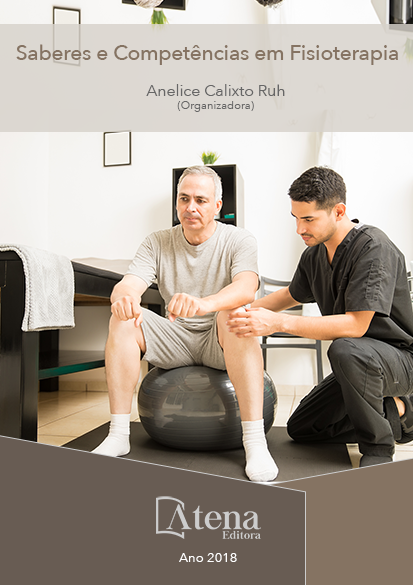
ANÁLISE DOS EFEITOS DO TREINAMENTO MUSCULAR RESPIRATÓRIO EM PACIENTES COM INSUFICIÊNCIA RENAL CRÔNICA EM HEMODIÁLISE
A Insuficiência Renal Crônica (IRC) é
uma síndrome metabólica decorrente da perda
progressiva da capacidade excretória renal, a
qual associada ao tratamento por hemodiálise
causa restrições e prejuízos no estado de saúde
dos pacientes. Este estudo objetivou avaliar os
efeitos do treinamento muscular respiratório
com threshold IMT na capacidade pulmonar
dos pacientes acometidos por IRC submetidos
a hemodiálise. A amostra foi de 07 pacientes
atendidos pelo Serviço Nefrológico Fiúza
Chaves (NEFRUZA), maiores de 18 anos, que
apresentem PiMáx ≤ -80 cmH2
0 (mulheres), e ≤
-100 cmH2
O (homens) durante a avaliação. Os
pacientes foram submetidos a uma avaliação
fisioterapêutica penumofuncional, utilizando
a Ventilometria e Manovacuômetria, sendo
reavaliados após 15 sessões. O protocolo
foi realizado com o incentivador respiratório
Threshold IMT, com carga de 30% da Pimáx
nas cinco primeiras sessões, progredindo para
40% da Pimáx nas cinco sessões seguintes,
finalizando o protocolo com 50% da Pimáx
nas últimas sessões, sendo realizadas
quatro séries com dez repetições. Foram
aferidos a PA, FC e FR, sendo observado
um aumento nas médias das variáveis PAS
(142,37±18,98 mmHg e 143,24±20,28 mmHg),
PAD (90,67±8,88 mmHg e 91,43±8,82 mmHg)
e FC (82,19±7,71bpm e 83,24±6,40bpm),
respectivamente antes e após a aplicação
do protocolo, tendo a FR (15,01±0,50irpm e
13,70±0,59irpm) apresentada redução após a
realização do mesmo. Quanto a PiMáx e VC não
houve variação significativa (-45,7±17,2mmHg
e -55,7±22,3mmHg; 599,1±443,2ml e
509,6±210,3ml, respectivamente), tendo apenas
a PeMáx apresentado variação significativa
(84,3±31,0mmHg e 106,4±35,2mmHg,
respectivamente). Com isso, o threshold IMT
não apresentou melhora significativa da variável
PiMáx, nem do VC.
ANÁLISE DOS EFEITOS DO TREINAMENTO MUSCULAR RESPIRATÓRIO EM PACIENTES COM INSUFICIÊNCIA RENAL CRÔNICA EM HEMODIÁLISE
-
DOI: 10.22533/at.ed.90118021232
-
Palavras-chave: Insuficiência Renal Crônica. Diálise renal. Fisioterapia. Exercícios Respiratórios.
-
Keywords: Chronic Renal Insufficiency. Renal dialysis. Physiotherapy. Respiratory Exercises.
-
Abstract:
Chronic Renal Insufficiency (CRF) is a metabolic syndrome resulting from
the progressive loss of renal excretory capacity, which is associated with hemodialysis
treatment, causing restrictions and impairments in the health status of patients. This
study aimed to evaluate the effects of respiratory muscle training with IMT threshold
in the pulmonary capacity of patients affected by CRI undergoing hemodialysis. The
sample consisted of 07 patients who underwent PiMax ≤ -80 cmH20 (women) and ≤
-100 cmH2O (men) who underwent the Neurological Service Fiúza Chaves (NEFRUZA)
over 18 years of age during the evaluation. The patients underwent a penumofunctional
physical therapy evaluation, using Ventilometry and Manovacuometry, being reassessed
after 15 sessions. The protocol was performed with the Threshold IMT respiratory
stimulator, with a 30% loading of Pimáx in the first five sessions, progressing to 40% of
Pimáx in the following five sessions, ending the protocol with 50% of Pimáx in the last
sessions, with four series with ten repetitions. PA, HR and RR were measured, with an
increase in mean SBP variables (142.37 ± 18.98 mmHg and 143.24 ± 20.28 mmHg),
DBP (90.67 ± 8.88 mmHg and 91 , 43 ± 8.82 mmHg) and HR (82.19 ± 7.71 bpm and
83.24 ± 6.40 bpm), respectively before and after the application of the protocol, with RF
(15.01 ± 0.50irpm and 13 , 70 ± 0.59irpm) presented reduction after its accomplishment.
There was no significant variation (p = 0.05) in both groups (p = 0.05 and p = 0.05).
Pemax presented significant variation (84.3 ± 31.0mmHg and 106.4 ± 35.2mmHg,
respectively). Therefore, the IMT threshold did not show a significant improvement of
the PiMáx variable, nor of the CV.
-
Número de páginas: 15
- Fábio Correia Lima Nepomuceno
- Juliane Maury Pereira Lucena
- LUCAS ARAÚJO SANTIAGO; MARCOS BARBOSA VEIGA DE MELO; JOYCE SILVA DOS SANTOS; PRYSCILA RUANA DA SILVA RODRIGUES


